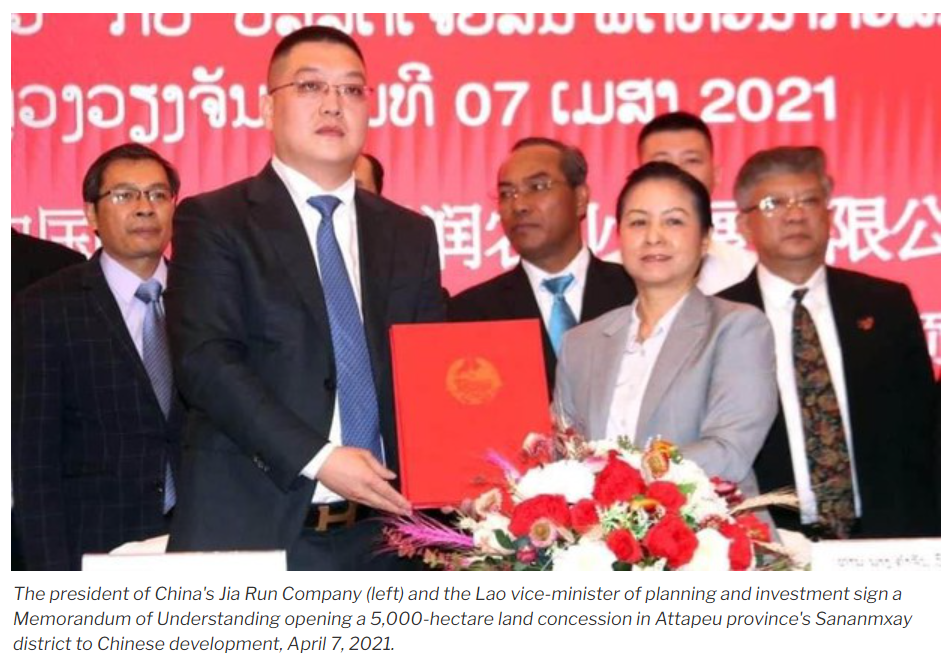Laos Opens More Land to Chinese Investment, Raising Local Concerns
A Chinese company has signed an agreement with Lao authorities to study the prospects for development of 5,000 hectares of land in southern Laos’ Attapeu province, raising concerns among residents that investors will take more land over time, destroying local livelihoods, Lao sources say.
The Memorandum of Understanding (MoU) signed on April 7 allows China’s Jia Run Company to carry out feasibility studies over the next six months on the land in Attapeu’s Sanamxay district, a provincial official told RFA’s Lao Service.
“The Chinese have already come several times to explore a large lot of land along the border with Pathumphone and Paksong districts,” the official working for Attapeu’s Agriculture and Forestry Department said.
“They plan to plant trees with commercial value, like eucalyptus, durian, and jackfruit trees,” the official added, speaking on condition of anonymity.
The agreement signed in the capital Vientiane between the president of Jia Run and Khamchanh Vongsaenboun, Lao vice-minister of planning and investment, allows the Jia Run Company now to invest up to one billion yuan (U.S. $152 million) to develop the project, according to state media reports.
The company also expects to employ 50,000 Laotians and build 20 schools and 20 health centers for local communities, state media said.
Speaking to RFA after the agreement was announced, villagers in Sanamxay district voiced doubts over the project’s promised benefits to local residents, saying Chinese promises are rarely kept.
“This project will certainly affect our livelihoods and the environment,” one district resident said. “For example, a 3,000-hectare Chinese sugar cane and banana plantation in the area of Pindong village here in Sanamxay said at first that they would hire local villagers to work.”
“But they never did,” he said. “They just took the land.”
If the Lao government now grants this new concession of land to a Chinese investor, that company will eventually take all of the land and forest in the district, leaving local people with nothing to rely on for food, he said.
“We just found out that the government is going to give this land to the Chinese,” another district resident said. “We’re worried now that the investor will also take our land, rice fields, and vegetable gardens.”
“If that happens, we won’t have any land to farm. All we can do is work as laborers for the Chinese,” he said.
‘They get what they want’
A third villager in the same district said it will be impossible to oppose the project now, in spite of residents’ concerns.
“If they want land anywhere in Laos, they will get it, because they have a lot of money,” the villager said, also asking that his name not be used out of fear for his safety.
“But what can we do? They take land not only here, but all over the country.”
A shopkeeper in Sanamxay said however that he favored the planned Chinese project, adding, “I want to see more investment, the more the better.”
“More investment will bring more business, and that is how our country will develop. This way our people will have jobs and income,” he said.
Land grabs, pollution
Much of Laos’s recent economic growth has been generated through land concessions to China, Thailand, and Vietnam to exploit natural resources including timber, agricultural products, minerals, and energy. But the policies have sparked friction over cases of environmental pollution and land taken without proper compensation.
Lao villagers affected by land grabs often fear to speak out publicly over their concerns because they fear official retribution.
Reports have increased in recent years of growing resentment in Laos over China’s business presence and influence in the country, with several Chinese-language schools opening in Vientiane during the last several years as Beijing’s investments in the Southeast Asian country point to a future where Chinese companies dominate local commerce.
Concern has also been growing over China’s massive investment in hydropower dams, a major railway, and other infrastructure projects under Beijing’s $1.3 billion Belt and Road Initiative.
In September, Laos and a majority Chinese-owned company signed a 25-year concession agreement allowing the company to build and manage Laos’s power grid, including electricity exports to neighboring countries, sources told RFA in earlier reports.
Reported by RFA’s Lao Service. Translated by Max Avary. Written in English by Richard Finney.
Source: https://www.rfa.org/english/news/laos/land-04142021144544.html


 English
English




